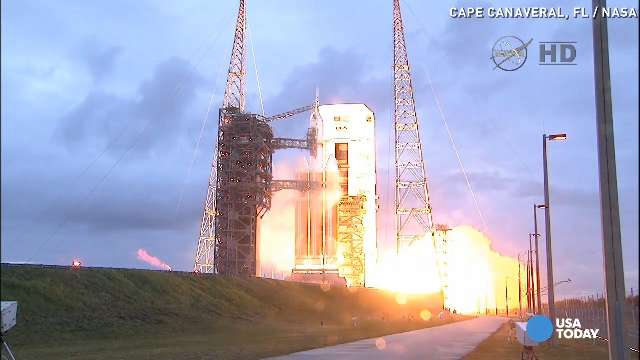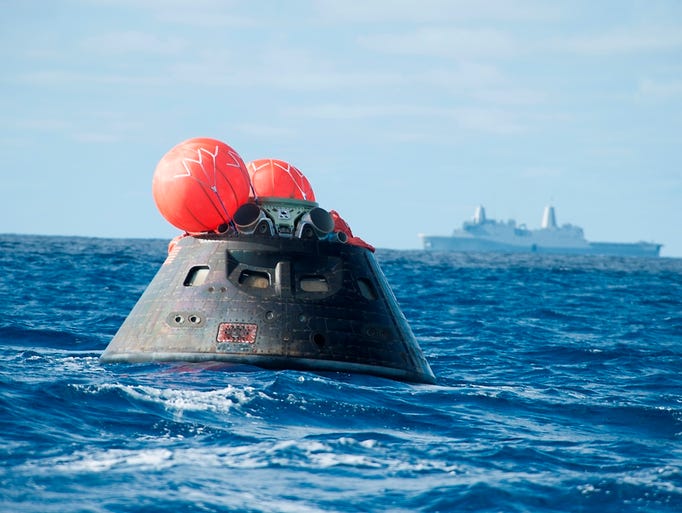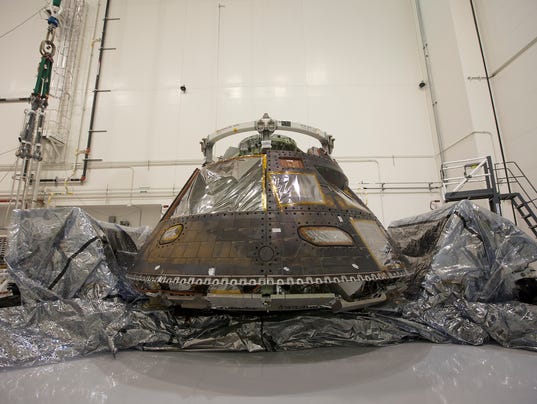Strict Standards: Only variables should be assigned by reference in /home/noahjames7/public_html/modules/mod_flexi_customcode/tmpl/default.php on line 24
Strict Standards: Non-static method modFlexiCustomCode::parsePHPviaFile() should not be called statically in /home/noahjames7/public_html/modules/mod_flexi_customcode/tmpl/default.php on line 54
Strict Standards: Only variables should be assigned by reference in /home/noahjames7/public_html/components/com_grid/GridBuilder.php on line 29

UP NEXT
03
NASA's unmanned Orion spacecraft blasted off Friday. Its first launch attempt was scrubbed Thursday due to several factors, including wind. NASA hopes the spacecraft will eventually take astronauts to Mars. VPC
CAPE CANAVERAL, Fla. -- Nearly eight more years may pass before astronauts launch from Kennedy Space Center in an Orion exploration capsule, NASA announced Wednesday.
The space agency said the Orion spacecraft — now nearly a decade and more than $10 billion into its development — would be ready to fly its first crew no later than April 2023, about 20 months later than the previous target date.
NASA downplayed the significance of the potential delay, saying the flight is only the start of what could be decades of Orion missions exploring deep space, first around the moon and potentially to Mars.
“I wouldn’t get too worried about these schedules,” said Bill Gerstenmaier, head of NASA’s human spaceflight programs. “We can get to where we can have a very functional capability that’s affordable, and we can continue to fly these exploration missions that will ultimately get us ready to go to Mars.”
Based on the new target date, NASA expects to spend more than $17 billion to develop Orion, which can support a crew of up to four astronauts for up to 21 days.
Before astronauts fly on Orion, they are expected to launch from KSC and Cape Canaveral Air Force Station on commercial capsules bound for the International Space Station in low Earth orbit. Those flights are targeted for late 2017.
Work on Orion, which can fly further out in space, began in 2006 under NASA’s Constellation program, which envisioned astronauts establishing a lunar habitat before moving on to Mars. The Obama administration cancelled the program in 2010 after a panel determined it was years behind schedule.
Orion survived the transition, shifting from rides on the canceled Ares I rocket to NASA’s Saturn V-class Space Launch System rocket.
Under the revised program, NASA says it will cost $11.3 billion to ready Orion to fly astronauts. That total, however, excludes nearly $6 billion spent during the Constellation years.
NASA and Lockheed Martin, the lead Orion contractor, continue to work toward a more ambitious date of August 2021 for the first crewed flight, but NASA acknowledged that timing is unrealistic.
“The team is working to that plan right now,” said Robert Lightfoot, NASA’s associate administrator. “It’s not a very high confidence level, I will tell you that, just because of the things we see historically pop up.”
Orion last December completed a successful uncrewed first trip in space, a two-orbit flight launched from Cape Canaveral Air Force Station by a Delta IV Heavy rocket.
Gerstenmaier said that nearly flawless flight showed that “we’re really putting together a capsule that will take humans beyond low Earth orbit and really push human presence into the solar system.”
The first launch of Orion on the 322-foot SLS rocket, without a crew, is planned by late 2018 if the capsule, SLS and ground systems at KSC are ready.
NASA doesn’t fully control the schedule for that mission called Exploration Mission-1, or EM-1, because it has partnered with the European Space Agency to provide the spacecraft’s power and propulsion module.
Orion’s next launch on SLS, labeled EM-2, is the one now anticipated to fly astronauts in 2023.
NASA hopes to fly one mission a year after that if budgets permit. A mission now under study would have an Orion crew visit a boulder that a robotic spacecraft has plucked from an asteroid and dragged to an orbit around the moon, where the astronauts could reach it by the mid-2020s.
NASA is already implementing several design changes intended to shave about 500 hundred pounds from Orion and make it easier and less expensive to build.
For example, a heat shield originally designed as a single large structure will now be comprised of smaller blocks.
While the first flight of astronauts on Orion now is on track to occur late in the next president’s possible second term, Gerstenmaier said there was reason for excitement about the deep space human exploration it will help enable.
“You can kind of fast forward a little bit, and with my operations background, I can see the future of how we can really use this hardware in pretty amazing ways,” he said.
Read or Share this story: http://usat.ly/1iT07v3

Strict Standards: Only variables should be assigned by reference in /home/noahjames7/public_html/modules/mod_flexi_customcode/tmpl/default.php on line 24
Strict Standards: Non-static method modFlexiCustomCode::parsePHPviaFile() should not be called statically in /home/noahjames7/public_html/modules/mod_flexi_customcode/tmpl/default.php on line 54
Find out more by searching for it!

